Phenoxazine-based supramolecular tetrahedron as biomimetic lectin for glucosamine recognition
2021-05-14YuchaoLiXuezhaoLiLiliLiBingXiaoJinguoWuHechuanLiDanyangLiChengHe
Yuchao Li,Xuezhao Li*,Lili Li,Bing Xiao,Jinguo Wu,Hechuan Li,Danyang Li,Cheng He*
State Key Laboratory of Fine Chemicals, Dalian University of Technology, Dalian 116024, China
ABSTRACT The design and synthesis of a phenoxazine-based metal-organic tetrahedron(Zn4L4)as biomimetic lectin for selectively recognition of glucosamine (GlcN) was reported.Different from the free phenoxazinebased ligand(L),Zn4L4displayed the highest fluorescent intensity enhancement efficiency toward GlcN over other related natural mono- and disaccharides.Fluorescence titration demonstrated a 1:1 stoichiometric host-guest complex was formed with an association constant about 4.03 1H NMR spectroscopic studies confirmed this selectivity resulted from the multiple hydrogen bonding interactions formed between GlcN and Zn4L4.The present results suggested that rational arrangement of recognition sites in the confined space of metal-organic cage is crucial for the selectivity toward target guests.
Keywords:Glucosamine Phenoxazine Metal-organic cage Fluorescence Host-guest complex
Carbohydrates, as the carriers of energy in life, are essential mediators of a wide range of biological processes including protein folding, cell-cell recognition, infection by pathogens or tumor metastasis [1,2].The recognition of carbohydrates with high specificity and sensitivity is biologically important but intrinsically challenging, for both nature and host-guest chemists [3–5].Saccharides are high hydrophilic, non-charged, subtle variation of the three-dimensional structures, and the only one kind of the recognition units are the hydrogen bonding groups.Even the most common class of natural receptors, lectins, show notably low affinities and modest selectivity [6,7].Biomimetic synthetic organic-box-like lectins equipped with multi-hydrogen bonding groups in their inner cavities have been devoted to sensor saccharides operating through non-covalent interactions [8–16].However, these purely organic hosts [17–21] commonly required lengthy and low-yielding synthetic process.Noted that complexation of saccharides with an organic host receptor was often detected by the1H NMR chemical-shift changes [22–28], but this method showed a limited sensitivity.Alternatively, the using of fluorescence spectroscopic method to recognize target carbohydrates is highly anticipant.This method possesses excellent signaling properties to modulate the binding process and thus might leave an improved detection sensitivity [29,30].
On the other hand,self-assembled metal-organic cages(MOCs)with unique hollow cavity environment and rich chemical/physical properties enable them as promising receptors for various compounds recognition [31–33].The abundant structural configurations and fruitful functionalities can be successfully achieved by rational selection of different metal centers and well-designed ligands.Especially, when amide groups as multiple hydrogen bonding triggers used in nature protein–carbohydrate complexes were incorporated into MOCs, the novel synthetic hosts could be used as efficient receptors for mimicking biological carbohydrate recognition processes [34–38].The key issues remain how to subtly modulate the distribution of recognition sites,as well as to form appropriate shape and size to encapsulate specific saccharides.Furthermore, fluorescent properties are also desired by integrating emissive ligands and/or coordination complexes into the supramolecular architectures[39] to possess improved signal output properties.
Herein,the design and synthesis of a metal-organic tetrahedron(Zn4L4) equipped with four phenoxazinean-based signaling components and a dozen of amide-based hydrogen binding sites as biomimetic lectin for selectively recognition of glucosamine(GlcN) over other related natural mono- and disaccharides was reported (Scheme 1).By contrast, free phenoxazine-based ligand(L) showed no obvious enhancement of the fluorescent intensity towards GlcN.Fluorescence titration and ESI-MS studies demonstrated that the newly obtained biomimetic lectin host could encapsulate one GlcN in the cavity environment of Zn4L4with high association constant.1H NMR spectroscopic studies confirmed that the selectivity resulted from the complementary multiple hydrogen bonding interactions between amine,hydroxy groups of GlcN and the amide moieties of Zn4L4.The present results suggested that rational arrangement of recognition sites in the confined space of metal-organic cage is crucial for the selectivity toward target guests, and the supramolecular host-guest species formation between the cage containing hydrogen-bond recognition sites and the encapsulated carbohydrates is responsible for the effective detection process.
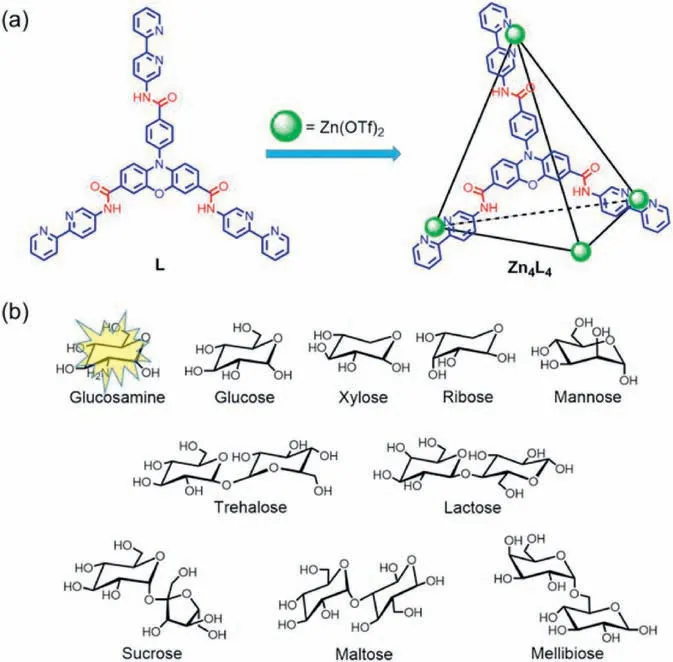
Scheme 1.(a) Coordination-driven self-assembly of metal-organic tetrahedron Zn4L4; (b) Mono- and disaccharides used in the recognition experiments.
As shown in Fig.1a, ligand L was obtained by connecting phenoxazine-based core(1)and 2,20-bipyridine chelators through amine-linkages in two steps [40–42].Acylating of 1 with thionyl chloride,and subsequently reacted with 2 to afford ligand L in 78%yield.The successfully obtained ligand L was confirmed by1H and13C NMR spectra (Fig.1b and Section S2 in Supporting information).The reaction of ligand L(1.0 equiv.)and Zn(OTf)2(1.0 equiv.)(OTf=trifluoromethanesulfonate)in DMF at 80for 12 h resulted in the formation of Zn4L4as the unique product.The1H NMR spectra of tetrahedron Zn4L4displayed only one set of ligand resonances in solution, suggesting the exclusive formation of a discrete structure to be highly symmetrical (Fig.1c).Diffusionordered NMR spectroscopy(DOSY)of the product also showed that the multiple aromatic signals possessed similar diffusion coefficients (m2/s, Fig.S8 in Supporting information).
The formation of a discrete supramolecular species containing a Zn4L48+cation was confirmed by electrospray ionization time-offlight mass spectrometry (ESI-TOF MS).As showed in Fig.1d, a series of intense peaks at m/z=458.0999, 544.8200, 660.4491,822.3308,1065.1522 and 1469.8522 were observed.Comparison of the experimental peaks with these simulated results obtained on the basis of natural isotopic abundance, these peaks were safely assigned to the species [Zn4(L)4]8+(calcd.458.1022),[Zn4(L)4+OTf]7+(calcd.544.8243), [Zn4(L)4+2OTf]6+(calcd.660.4538), [Zn4(L)4+3OTf]5+(calcd.822.3351), [Zn4(L)4+4OTf]4+(calcd.1065.1570)and[Zn4(L)4+5OTf]3+(calcd.1469.8602),respectively.This result demonstrated the Zn-based tetrahedral architecture was successfully assembled with substantially stability in solution.
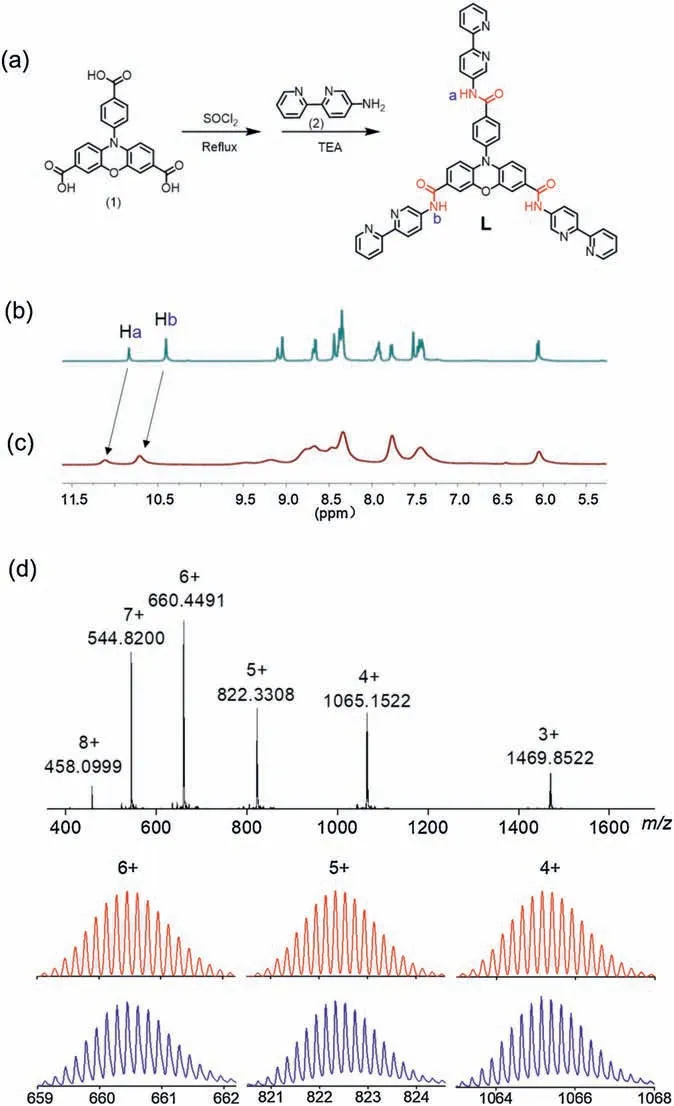
Fig.1.(a)Schematic pathway for the synthesis of phenoxazine-containing ligand L,which inserting three amide groups.Sections of the 1H NMR spectra (400 MHz in DMSO-d6)of ligand L(b)and the tetrahedron Zn4L4(c).(d)ESI-TOF MS spectrum of Zn4L4in DMF and the expanded MS peaks of Zn4L4with charges +6 to +4.The experimental results were shown in blue(bottom)and the calculated results were shown in red (top).
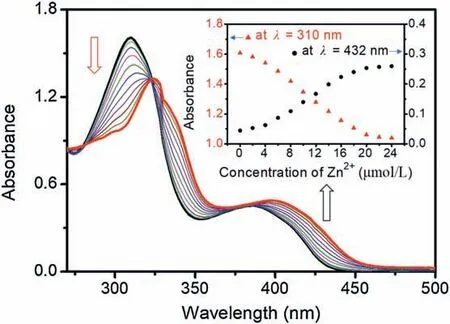
Fig.2.UV–vis titration of ligand L(20.0mol/L)with the addition of Zn(OTf)2(0-24.0mol/L) in CH3CN: DMF=4:1 (v:v).Inset: Absorbance variation curves of L upon the addition of Zn2+at 310 nm and 432 nm.

Numerous efforts for crystallization of Zn4L4to obtain suitable crystals for the high-quality X-ray diffraction have been unsuccessful.Therefore, in order to understand the three-dimensional structure of Zn4L4better,we use a MM2 energy-minimized model to simulate the structure of Zn4L4(Fig.3).Through the optimized structures, we can more intuitively insight that the Zn4L4was a twisted tetrahedron structure with a hollow cavity.The four metal atoms occupied the vertices and each of them was coordinated with three ligands.Each ligand was positioned on one of the four faces of the tetrahedron which defined by four metal ions.Thedistance in the long edges of Zn4L4was about 19.38(1)Å,and in the short edges was about 18.34(1)Å.The average dihedral angle between the phenyl groups and phenoxazine planes in Zn4L4was about 74.41(1)The structure possessed a confined cavity and contains 12 amide groups, which provides a great possibility for carbohydrate recognition.
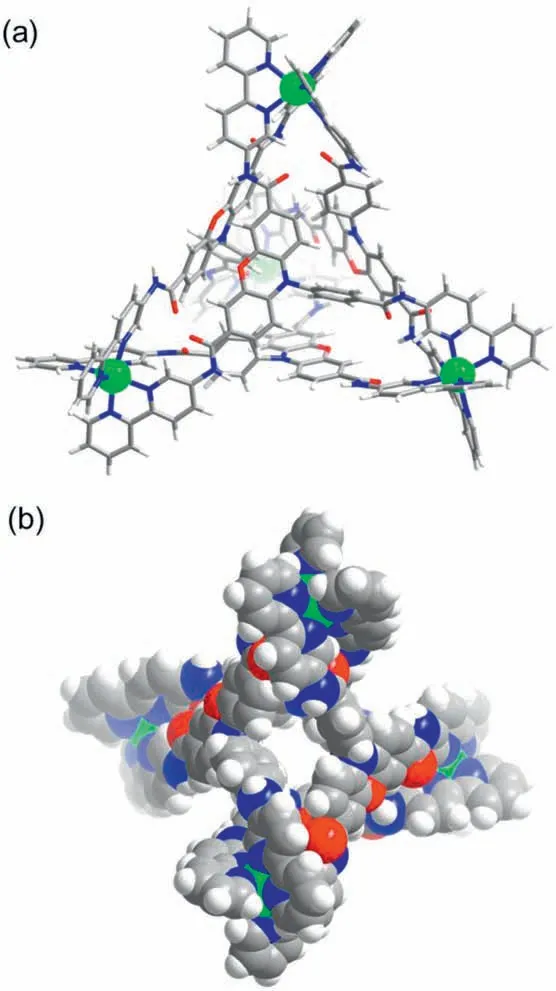
Fig.3.The optimized structure of Zn4L4.(a) Ball-and-stick model (Zn atoms are shown as green spheres); (b) Space-filling model.Disorder atoms and solvent molecules of crystallization are omitted for clarity.Color code: C=gray; N=blue;O=red; H=white; Zn=green.
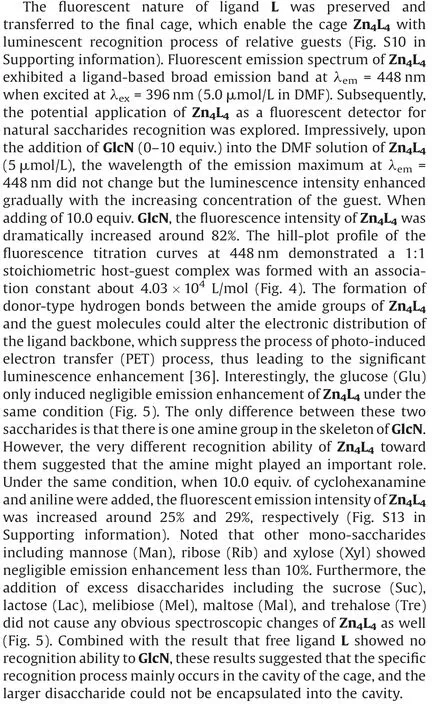
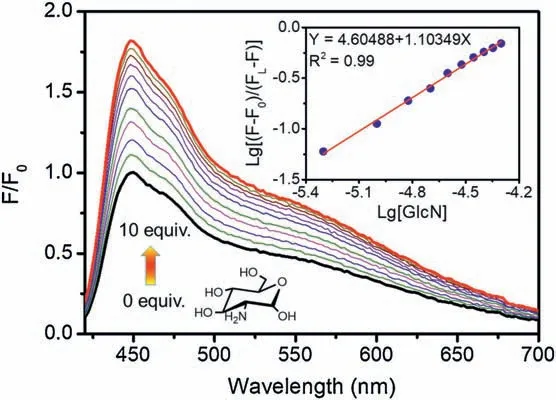
Fig.4.Family of luminescence spectra of Zn4L4(5 mmol/L) upon the addition of different concentrations GlcN (0-10.0 equiv.).Inset: Hill-plot titration curve showing the 1:1 host–guest behavior.
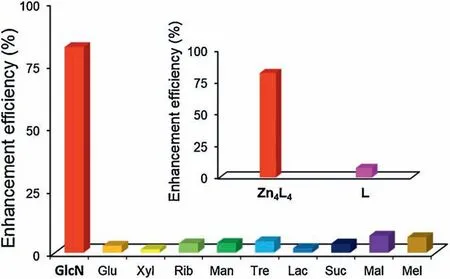
Fig.5.The fluorescent emission enhancement efficiency of Zn4L4upon addition of different carbohydrates.Inset: different fluorescent emission enhancement efficiency of Zn4L4and L toward GlcN.
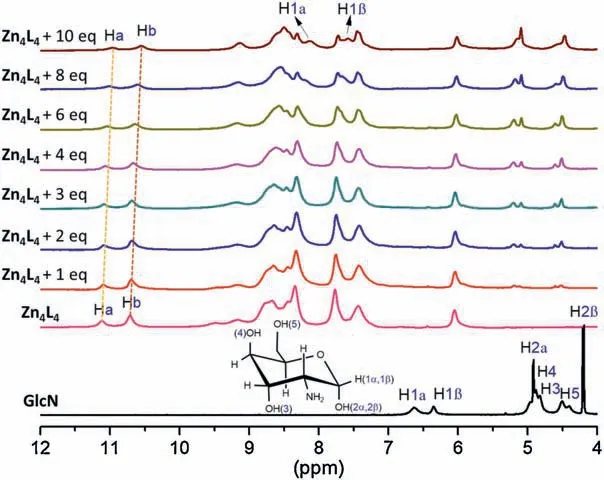
Fig.6.1H NMR titration(400 MHz in DMSO-d6)of Zn4L4(10 mmol/L)upon addition of GlcN (0-10.0 equiv.).


In summary, we reported a supramolecular tetrahedron as biomimetic lectin for GlcN recognition with high specificity and sensitivity over other related natural mono-and disaccharides.The Zn4L4displayed phenoxazine-based broad fluorescent emission property, and equipment of 12 amide groups in the skeleton.The formation of a 1:1 host-guest complexes has been characterized by fluorescence titration spectroscopy and ESI-MS.1H NMR spectroscopic titration studies and NOESY spectra confirmed that the hydrogen bonding interactions between GlcN and receptor Zn4L4,resulting a stronger host-guest binding affinity.The present results demonstrated that the rational distribution of amide groups and luminescent ligands into the 3D metal-organic cage structure not only provides a recognizable hydrogen-bonding functional site for the guest molecule, which facilitates the formation of the hostguest complex, but also provides a way to convert identification information into effective communicator for optical signals.Accordingly, changing the topology and the arrangement of hydrogen binding sites in the confined space of host,the selectivity toward other target guests could be expected.
Declaration of competing interest
The authors declare that they have no known competing financial interests or personal relationships that could have appeared to influence the work reported in this paper.
Acknowledgments
We appreciate the National Natural Science Foundation of China (Nos.21701019 and 21861132004) and Doctoral Scientific Research Launching Fund Project of Liaoning province (No.2019-BS-050).
Appendix A.Supplementary data
Supplementarymaterialrelatedtothisarticlecanbefound,inthe online version,at doi:https://doi.org/10.1016/j.cclet.2020.07.028.
杂志排行
Chinese Chemical Letters的其它文章
- Quantitative assessment of rhodamine spectra
- Copper-cobalt-nickel oxide nanowire arrays on copper foams as self-standing anode materials for lithium ion batteries
- Design of activatable red-emissive assay for cysteine detection in aqueous medium with aggregation induced emission characteristics
- An aqueous zinc-ion hybrid super-capacitor for achieving ultrahigh-volumetric energy density
- Assembly and packing models of [Ti6Co12] ring based on the titanium-capped cobalt clathrochelates
- A stable Co(II)-based metal-organic framework with dual-functional pyrazolate-carboxylate ligand: Construction and CO2selective adsorption and fixation
